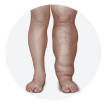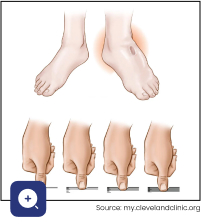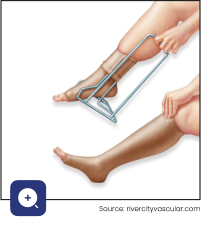
The Basics
Occasionally, a systemic condition results in swelling, which is much more marked on one side than the other, which may make the diagnosis more challenging.
Other important clues as to the possible cause include the speed of onset (sudden or slowly), how long it has been a problem and the accompanying symptoms, e.g. pain or changes in skin colour.
Systemic causes of swollen legs include:
- Heart failure
- Liver failure
- Kidney disease
- Conditions which lead to low protein levels in the blood (with seepage of fluids out of the vessels into the tissues)
- Side effects of medication, e.g. medication for high blood pressure
- Low thyroid levels
Localised causes of swollen legs include:
- Trauma – there will usually be a history of some form of incident, e.g. a fall or car accident which resulted in bleeding and swelling.
- Chronic venous insufficiency or deep vein thrombosis – both legs may be affected.
- An infection or local inflammation, e.g. cellulitis (bacterial infection), allergy, or arthritis.
- Blockage of the drainage of lymph – lymph is the term for the clear components of blood, which seep into the tissues. The lymphatic system drains and transports this fluid back to the bloodstream.
- Benign or cancerous growths or collections of fluid, e.g. popliteal cysts behind the knee.
- An immobile leg, e.g. from paralysis.
- Lipoedema – an abnormal build-up of fat in the legs (but not feet), and sometimes arms, of women (and occasionally men with abnormal hormone levels). This abnormality is linked to hormone levels, and it typically starts very gradually in puberty and gets worse progressively.
Symptoms
Signs your legs are swollen:
- Indents left on your skin when you remove your socks or pant legs.
- Legs or feet that feel heavy, numb, or itchy.
- Skin that looks puffy, stretched, or shiny.
- Skin that feels tight or painful.
Risks
If left untreated, oedema can cause:
- Swelling that gets increasingly painful.
- Problems walking.
- Stiffness.
- Stretched skin, which can itch.
- Increased risk of infection in the swollen area.
- Scarring between layers of tissue.
- Less blood flow.
- Less ability of the arteries, veins, joints, and muscles to stretch.
How is the cause of the swelling diagnosed?
Detailed questioning by your doctor is key to establishing the possibilities and which initial tests are most appropriate. In more challenging cases, where initial tests do not provide confirmation of the suspected diagnosis, more extensive testing may be needed. For example:
- basic blood and urine checks
- duplex doppler ultrasound examination
- chest X-ray and ECG (an electrocardiogram records the way your heart beats)
- tests which indicate the risk of bleeding or clotting
What are the treatments for swollen legs?
The treatment will depend on the underlying cause. The doctors at Cape Town Vascular have the necessary expert knowledge to guide further management.
Treatment of swollen legs, often referred to as oedema, includes several components:
- treatment of the underlying cause (if possible)
- reducing the amount of salt (sodium) in your diet
- use of a diuretic to eliminate excess fluid
- complete decongestive treatment with a lymphoedema therapist
- long-term Class 2 compression stockings
- exercise
- losing weight
- Symptoms
- Risks
- Surgical Procedures
Signs your legs are swollen:
- Indents left on your skin when you remove your socks or pant legs.
- Legs or feet that feel heavy, numb or itchy.
- Skin that looks puffy, stretched or shiny.
- Skin that feels tight or painful.
If left untreated, edema can cause:
- Swelling that gets more and more painful.
- Problems walking.
- Stiffness.
- Stretched skin, which can itch.
- Increased risk of infection in the swollen area.
- Scarring between layers of tissue.
- Less blood flow.
- Less ability of the of arteries, veins, joints and muscles to stretch.













